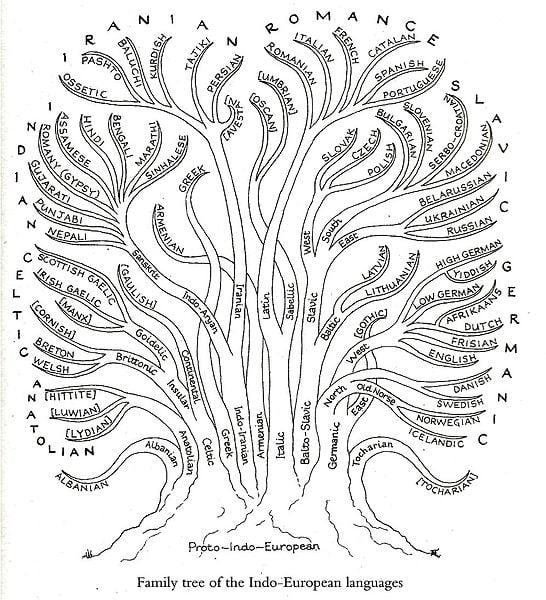Table of Contents (click to expand)
Languages of the world are can be classified into families based on their evolution. ‘Linguistic distance’ denotes how similar one language is to another. The closeness of a language to one’s native language determines one’s difficulty in learning it.
There are roughly 6500 languages that are still spoken in this world. Among these, few of them are spoken by a significantly larger number of people than others. This often makes it necessary to learn the most popular languages in order to communicate globally. English and Chinese are common examples of such languages.

But often, there are hurdles to learning these languages. People from different countries report varied difficulty in learning them. For example, someone from Europe would find it easier to learn English, as compared to Chinese. Similarly, for someone from Japan, learning Chinese would be relatively easy, as compared to English. Why is this the case? What are the factors that affect the difficulty of learning a language?
Recommended Video for you:
Language ‘Trees’
To understand why languages differ in difficulty, we first need to try to understand their similarities and differences. A German linguist, August Schleicher, was the first to do this in the 1850s by using tree-like diagrams that trace the origins of each language.

Linguists who succeeded him continued this work and studied the evolution of world languages and arranged them into ‘trees’ that map out their history and relationships. In this method, languages that are evolutionarily closer and have the same ancestor are grouped under one family.
For example, the Indo-European family includes languages of Europe, and parts of the Indian and Iranian region. Among these, the European languages are evolutionarily closer to each other and form one sub-group, whereas Indian languages form another group. Based on this, it can be seen that French and Spanish have more in common with each other. This makes it easier for a native French speaker to learn Spanish, as compared to an evolutionarily farther relative, such as Hindi.
It’s interesting to note that this classification has little to do with geography. While languages spoken in the Northern half of India fall under the Indo-European family, others spoken in Southern region fall into a distinct ‘Dravidian’ family. This makes it difficult for a native speaker of a Northern Indian language, such as Hindi, to learn a Southern Indian language like Tamil.
This explains why a person might have an easier time learning one language over another.
Linguistic Distance
The theory of ‘language trees’ is helpful to understand the relative difficulty of learning one language over another for the same individual. Now, let’s look at another interesting phenomenon where the converse happens – different individuals report different difficulties for learning the same language.
The varied difficulty of learning the same language received a spotlight due to non-English speakers immigrating into English-speaking nations. Linguists noted that immigrants with different native languages varied in their ability in learning English. They proposed that this might be because the native languages of these immigrants varied in similarity with respect to English, as per the ‘language tree’ hypothesis.
They devised a measure called ‘linguistic distance’ denoting the degree of similarity of one language with respect to another. They did this by studying the difficulty of learning different languages with respect to the English-speaking American population.
Interestingly, they noted that the proficiency of immigrants in English was correlated to the ‘linguistic distance’ of their native language from English. This meant that this measure was valid in a reciprocal fashion! Therefore, if a native Chinese speaker has difficulty learning English, a native English speaker faces the same level of difficulty in learning Chinese.

Linguistic distance has since been adapted to understand learning second languages other than English, such as to study the acquisition of European languages among people with varying native languages.
Other Factors Affecting Language Learning
In addition to linguistic distance, there are several other factors that decide the difficulty with which one learns a language. This includes, for example, the ability to pick up the sounds of the new language, or its ‘phonology’. This ability determines how ‘native-like’ someone sounds when speaking a language. This also seems to be significantly influenced by the learner’s age at the onset of learning.
We are generally better at acquiring ‘native-like’ accents when we learn them at a young age. This is because our perception of sounds of a language has a ‘critical period’ after which it becomes significantly less efficient.

This is why children are better at sounding ‘native-like’ than adults after spending the same amount of time in a new country after immigration and despite sharing the same native language. Due to this, it is easier for adults who are well past their critical period to pick up languages that don’t require learning new sounds.
Furthermore, languages also differ in their word order and grammatical rules such as the use of gender, etc. However, the most significant factor influencing second language learning seems to be linguistic distance.
Conclusion
Languages of the world are diverse, but based on linguistic evolution, they can be classified into families organized in a language tree. A measure called ‘linguistic distance’ denotes how far language A is from language B based on their location in this ‘language tree’. This measure decides how close or similar one language is to another.
The closeness of a language to one’s native language determines the difficulty in learning it. This is because our brains define new experiences based on prior experiences. Thus, our native language shapes our foreign or second language learning.
In short, it would be a good idea to look up your native language on the ‘language tree’ before deciding which foreign language you want to learn. Next time you have a bad time recalling all the rules of grammar in French, just blame it on your mother tongue!
References (click to expand)
- Three early language trees in the history of linguistics. A .... ResearchGate
- (1995) Language-tree divergence times support the Anatolian theory .... mapageweb.umontreal.ca
- Chiswick, B. R., & Miller, P. W. (2005, January 15). Linguistic Distance: A Quantitative Measure of the Distance Between English and Other Languages. Journal of Multilingual and Multicultural Development. Informa UK Limited.
- Van der Slik, F. W. P. (2010, June 29). Acquisition Of Dutch As A Second Language. Studies in Second Language Acquisition. Cambridge University Press (CUP).
- (1979) SECOND LANGUAGE ACQUISITION - JSTOR. JSTOR
- Edwards J. G. H.,& Zampini M. L. (2008). Phonology and Second Language Acquisition. John Benjamins Publishing
- FLEGE, J. E. (1987, June 1). A Critical Period for Learning to Pronounce Foreign Languages?. Applied Linguistics. Oxford University Press (OUP).












